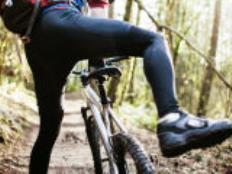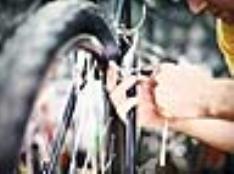Riding or racing in a pack can turn a small error into a dangerous one. When you make an error in a pack, chances are that not only will you crash, others will to. To keep yourself and others safe, it's important to continue to improve your bike-handling skills.
Some of the more common mistakes cyclists make out on the road include missed clip-ins and water-bottle fumbles. Here are easy ways you can learn to avoid them.
1. Missed Clip-In
1 of 6
One of the most common mistakes you can make on the bike is the missed clip-in at the start of an event (or even at a stoplight). Everyone has done it. Even experienced pros have a clip-in malfunction from time to time. The cause is almost always psychological. You start to worry that you'll miss the clip-in, and then you do. Pressure to jump off the front at the start, especially when you're in the pack, can lead you to second guess your technique and miss the clip-in.
To avoid over-thinking the clip-in and risk missing it, try these tips when using single-sided pedals:
1. Make sure your unclipped pedal is hanging motionless with the backside down.
2. Push off with your clipped-in foot and raise your other foot to meet the motionless pedal.
3. Tip the front of the pedal forward with your toe before your cleat engages the locking mechanism.
4. Once the pedal is horizontal, use additional pressure to seat the cleat.
If after some practice you're still having trouble, consider swapping out your pedals for a different technology. There are several varieties of double-sided pedals and cleats that can make the process a little easier.
Find:
Your Next Ride2. Water Bottle Wobble
2 of 6
This is not so much a bike-handling mistake as it is poor riding technique. The wobble occurs if and when you have to look down to find your water bottle to pull it out of the cage for a drink. When your eyes shift down, your brain loses spatial reference with the horizon, and you inevitably wobble from side-to side to regain balance. If you're in a pack, this wobble can cause an accident. Riders on either side or behind you will likely shout something nasty about "holding your line." At this point, you'll be labeled a squirrely rider by your colleagues or competitors.
You can prevent the wobble through practice. Try removing and re-inserting your water bottle with your eyes on the road ahead of you the next time you're out on the road. It isn't terribly difficult to remove the bottle; putting it back is a bit trickier. On solo training rides, repeat the process over until you can effortlessly remove and replace a water bottle from either cage without using your eyes. Once you have that down, concentrate on replacing the water bottle while maintaining a straight line. Try to keep your wheels on the painted white line on the side of the road as you handle the water bottle.
Find:
Your Next Ride3. Straight Arms over a Bump
3 of 6
Your arms and hands are two of five contact points between you and the bike. On bumpy roads, it's critical that the mass of your body is supported independently from the bike. Try to maintain a relaxed posture with slightly bent elbows. When the road gets bumpy, take weight off your saddle by transferring a small amount of body weight to your feet and hands. This might not feel natural at first, but with time, your elbow and shoulder joints will thank you with fewer stress-related injuries. You'll also be able to absorb those sudden unexpected bumps more easily.
Don't make the mistake of staying in the saddle when you encounter a dip in the road. This is a common mistake inexperienced riders make while racing criteriums. The corners on criteriums are also the spot where engineers design dips in the road for water runoff, which makes it easy to be bucked off the saddle when the rear wheel drops in and out of the dip. If you're lucky, you can maintain control and stay upright. Sometimes the rear wheel pops up and swings to the outside due to the force of the turn. When your tire impacts the road again, you can lose traction and crash.
The next time you're at a race, watch how experienced riders enter corners and see if their bikes dip. If the dip is significant, notice how racers will raise-up slightly off their saddle with bent elbows and allow the bike to drop down into the dip while keeping their upper body at a constant level. Their arms and legs serve as shock absorbers to allow the bicycle to move up and down following the road.
Your body is the largest mass in the whole human-machine equation. If it remains stable through the turn, you can always control the bike.
Find:
Your Next Ride4. Pedaling Through a Hard Turn
4 of 6
It's easy for a beginning racer or novice century rider to forget to raise the inside pedal during a turn. Once that inside pedal drags the pavement, you're almost certainly going to crash.
Admittedly, it's hard to gauge how steep a turn you can make while still turning the pedals. Trial and error isn't an option. Here's an easy rule of thumb: If you're making a right angle turn at race pace, raise your inside pedal. If you're following the gentle curve of a road, you can probably pedal through it.
Find:
Your Next Ride5. Sprinting with Hands on the Hoods
5 of 6
For beginners, riding the hoods can be more comfortable and make you feel like you have more control over the bike. Unfortunately, while it might feel more comfortable, you're losing a great deal of power due to a higher center of mass over the bike. By firmly holding the bars in the drops, you can exert more force on the pedals by transferring more of your strength though the handlebars. This results in more power going to the rear wheel for a faster sprint.
To conquer this skill, you'll need to practice standing on the pedals with your hands in the drops. At first, only try this alone on flat, smooth roads so that you don't lose your balance and crash. Once you're comfortable enough, practice increasing your speed or sprinting with one of your buddies on a low-traffic road.
Do you know other common bike-handling mistakes from your own experience? If so, drop me a note in the comment section below and I'll pass it on to the juniors I coach or use it for a future article.






Discuss This Article